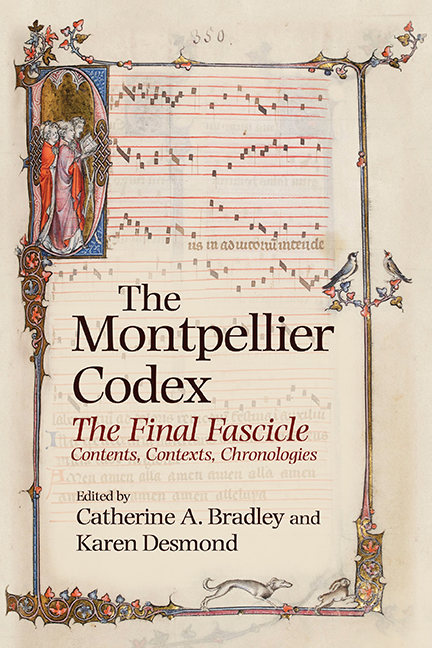Book contents
- Frontmatter
- Contents
- Figures
- Musical examples
- Tables
- Acknowledgements
- List of manuscript sigla
- Abbreviations
- Table of fascicle 8 contents
- Introduction
- I The Material Object
- II INNOVATION AND TRADITION
- III ANALYTICAL CASE STUDIES
- 13 Montpellier 8 PORTARE Motets and Tonal Exploration
- 14 Repetitions, Rhythmical Evolution, and Rhetoric in the Montpellier Codex
- 15 Shedding Light on Mo 8,304: Alma virgo virginum/Benedicta es, Maria
- 16 A Performance and Reception History of On parole/A Paris/FRESE NOUVELE
- Bibliography
- Contributors
- General index
- Index of compositions, alphabetical
- Index of compositions in Mo, manuscript order
- Miscellaneous Endmatter
14 - Repetitions, Rhythmical Evolution, and Rhetoric in the Montpellier Codex
from III - ANALYTICAL CASE STUDIES
Published online by Cambridge University Press: 04 July 2019
- Frontmatter
- Contents
- Figures
- Musical examples
- Tables
- Acknowledgements
- List of manuscript sigla
- Abbreviations
- Table of fascicle 8 contents
- Introduction
- I The Material Object
- II INNOVATION AND TRADITION
- III ANALYTICAL CASE STUDIES
- 13 Montpellier 8 PORTARE Motets and Tonal Exploration
- 14 Repetitions, Rhythmical Evolution, and Rhetoric in the Montpellier Codex
- 15 Shedding Light on Mo 8,304: Alma virgo virginum/Benedicta es, Maria
- 16 A Performance and Reception History of On parole/A Paris/FRESE NOUVELE
- Bibliography
- Contributors
- General index
- Index of compositions, alphabetical
- Index of compositions in Mo, manuscript order
- Miscellaneous Endmatter
Summary
IT is often claimed that medieval motets put sound before sense or meaning. This is largely because of their polytextuality. Many musicologists maintain that the declamation of several texts at the same time must necessarily obscure the words and hinder understanding. In addition, many believe that structural melodic patterns cannot exist in these motets because the influence of the pre-existent tenor citation on the musical polyphony is so restrictive. When melodic repetitions occur, they are assumed to be accidental. Within the confines of the motet, therefore, the existence of any meaningful relationships between texts and music seems hardly possible and it would be vain to expect any compositional intention of this kind.
These assertions are, however, only general suppositions. Scholars have also explored the role of texts in the polyphony more thoroughly. Through studies of structural form and rhythm, they have demonstrated links between poems and the melodies in the upper parts of some motets. I have demonstrated elsewhere that intricate relationships between texts and music at a closer range exist in many early motets on FLOS FILIUS, from the responsory Stirps Jesse. Despite the restrictions of the pre-existent tenor, the composers use melodic repetitions, high register, and intervals in the upper parts to create links between the organization of the poems and the shape of the melodies. However, these early motets may be unique. Some of these pieces are repetitive and these repetitions have typically been understood to be a result of their relationships to highly formulaic organa and clausulae. Composers may have reused pre-existent repetitions to create links between text and music. Besides, they are only preserved in manuscripts linked to the Magnus liber organi and in the so-called old corpus of Mo. This discussion, therefore, will focus on another tenor, the melisma SOLEM, to verify that such links between text and music could exist in other motets.
The tenor SOLEM comes from the responsory Solem justicie, sung on the feast of the Virgin Mary's Nativity from the eleventh century onwards. Fulbert of Chartres must have composed the chant specifically for this celebration, just like the other two responsories, Stirps Jesse and Ad nutum.
- Type
- Chapter
- Information
- The Montpellier CodexThe Final Fascicle. Contents, Contexts, Chronologies, pp. 254 - 268Publisher: Boydell & BrewerPrint publication year: 2018

